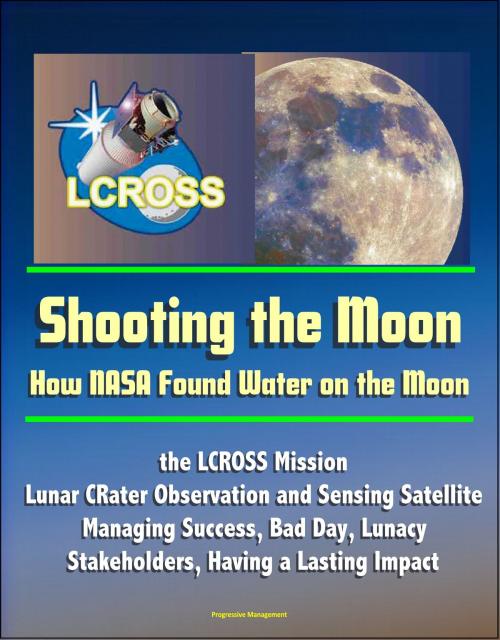Shooting the Moon: How NASA Found Water on the Moon, the LCROSS Mission - Lunar CRater Observation and Sensing Satellite - Managing Success, Bad Day, Lunacy, Stakeholders, Having a Lasting Impact
Nonfiction, Science & Nature, Technology, Aeronautics & Astronautics, Science, Physics, Astrophysics & Space Science| Author: | Progressive Management | ISBN: | 9781310852107 |
| Publisher: | Progressive Management | Publication: | May 1, 2015 |
| Imprint: | Smashwords Edition | Language: | English |
| Author: | Progressive Management |
| ISBN: | 9781310852107 |
| Publisher: | Progressive Management |
| Publication: | May 1, 2015 |
| Imprint: | Smashwords Edition |
| Language: | English |
Professionally converted for accurate flowing-text e-book format reproduction, this NASA document by the Lunar CRater Observation and Sensing Satellite (LCROSS) project manager, Daniel Andrews. This story is about an unlikely NASA mission to the Moon. It was unlikely because it was started with far too-little time and too-little money to complete. It was unlikely because it was able to take chances - to accept risk of failure. It was unlikely because it was searching for the unthinkable: water-ice on the moon. The mission of the Lunar CRater Observation and Sensing Satellite (LCROSS) was to investigate the possibility of water ice in craters on the Moon's poles. Perhaps most interesting are the implications this story has for managing any development effort, lunar or not, and working a balance to achieve success. NASA is by design a risk-taking agency within the US Government. It could be argued that NASA's purpose in the aerospace community is to take on the really big challenges that either the corporate world can't afford, are not yet profitable endeavors, or are just too risky for private corporations to entertain. However, expectations of the Agency have evolved. A combination of grim human tragedies and some very public cost and schedule overruns have challenged the public's and Congress's tolerance for risk-taking within the Agency. NASA, which is supposed to be in the business of taking risks to do bold, difficult things, has become less and less able to do so within its cost framework. Yet effectively replacing prudent risk management with attempts to "risk-eliminate" is completely unaffordable.
Chapter 1 - Introduction * Chapter 2 - In the Beginning * Chapter 3 - LCROSS Mission Overview * Chapter 4 - Faster, Better, Cheaper? * Chapter 5 - Managing the Project Basics * Chapter 6 - Managing the Project Phases * Chapter 7 - Managing the Project Staffing * Chapter 8 - Managing the PM - PSE Relationship * Chapter 9 - Managing the Success Criteria * Chapter 10 - Managing Design-to-Cost * Chapter 11 - Managing the Reserves * Chapter 12 - Managing the Schedule * Chapter 13 - Managing the Complexity * Chapter 14 - Managing Risk and Opportunities * Chapter 15 - Managing Risk Messaging * Chapter 16 - Managing Openness and Trust * Chapter 17 - Managing the Stakeholders * Chapter 18 - Managing the Middle * Chapter 19 - Managing the Big Decisions * Chapter 20 - Managing the Bad Day * Chapter 21 - Managing the Lunacy * Chapter 22 - Calibrating Our Approach * Chapter 23 - A Lasting Impact * Chapter 24 - In the End * Appendix A - Tips and Tricks of the LCROSS Project * Appendix B - Wisecracks and Wisdom - LCROSS Notable Quotables * Appendix C - LCROSS Quick Mission Facts * Appendix D - Timeline Notes from Propellant Anomaly
Professionally converted for accurate flowing-text e-book format reproduction, this NASA document by the Lunar CRater Observation and Sensing Satellite (LCROSS) project manager, Daniel Andrews. This story is about an unlikely NASA mission to the Moon. It was unlikely because it was started with far too-little time and too-little money to complete. It was unlikely because it was able to take chances - to accept risk of failure. It was unlikely because it was searching for the unthinkable: water-ice on the moon. The mission of the Lunar CRater Observation and Sensing Satellite (LCROSS) was to investigate the possibility of water ice in craters on the Moon's poles. Perhaps most interesting are the implications this story has for managing any development effort, lunar or not, and working a balance to achieve success. NASA is by design a risk-taking agency within the US Government. It could be argued that NASA's purpose in the aerospace community is to take on the really big challenges that either the corporate world can't afford, are not yet profitable endeavors, or are just too risky for private corporations to entertain. However, expectations of the Agency have evolved. A combination of grim human tragedies and some very public cost and schedule overruns have challenged the public's and Congress's tolerance for risk-taking within the Agency. NASA, which is supposed to be in the business of taking risks to do bold, difficult things, has become less and less able to do so within its cost framework. Yet effectively replacing prudent risk management with attempts to "risk-eliminate" is completely unaffordable.
Chapter 1 - Introduction * Chapter 2 - In the Beginning * Chapter 3 - LCROSS Mission Overview * Chapter 4 - Faster, Better, Cheaper? * Chapter 5 - Managing the Project Basics * Chapter 6 - Managing the Project Phases * Chapter 7 - Managing the Project Staffing * Chapter 8 - Managing the PM - PSE Relationship * Chapter 9 - Managing the Success Criteria * Chapter 10 - Managing Design-to-Cost * Chapter 11 - Managing the Reserves * Chapter 12 - Managing the Schedule * Chapter 13 - Managing the Complexity * Chapter 14 - Managing Risk and Opportunities * Chapter 15 - Managing Risk Messaging * Chapter 16 - Managing Openness and Trust * Chapter 17 - Managing the Stakeholders * Chapter 18 - Managing the Middle * Chapter 19 - Managing the Big Decisions * Chapter 20 - Managing the Bad Day * Chapter 21 - Managing the Lunacy * Chapter 22 - Calibrating Our Approach * Chapter 23 - A Lasting Impact * Chapter 24 - In the End * Appendix A - Tips and Tricks of the LCROSS Project * Appendix B - Wisecracks and Wisdom - LCROSS Notable Quotables * Appendix C - LCROSS Quick Mission Facts * Appendix D - Timeline Notes from Propellant Anomaly















